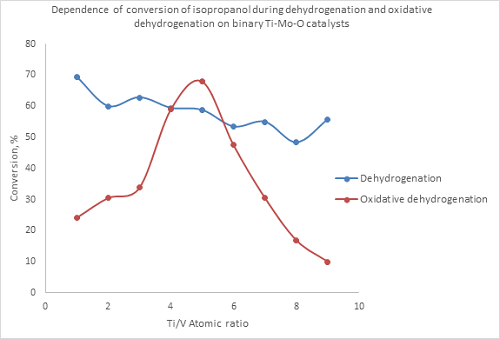
Isopropanol conversion over binary titan vanadium oxide catalysts
Abstract
Isopropanol conversion over binary titan vanadium oxide catalysts in the presence and absence of oxygen were studied. It was shown that acetone and propylene are the main products of the isopropanol dehydrogenation reaction over studied catalysts. It is established that in the isopropanol dehydrogenation reaction over titanium-vanadium oxide catalysts, the samples with an equimolar ratio of initial elements are highly active. In the dehydrogenation reaction of isopropyl alcohol in the presence of oxygen, except for the catalyst Ti-V=1-9, all other binary titanium-vanadium oxide catalysts have high activity in the propylene formation reaction. It was found that on binary titan-vanadium oxide catalysts in the isopropanol dehydrogenation reaction in the absence of oxygen, the increase in surface acidity leads to an enhancement in acetone yield and a lowering in propylene yield. In the isopropanol dehydrogenation reaction in the presence of oxygen, the change of surface acidity does not lead to a change in the yields of reaction products.
Full Text:
PDFReferences
C. Autthanit, P. Praserthdam, B. Jongsomjit, Oxidative and non-oxidative dehydrogenation of ethanol to acetaldehyde over different VOx/SBA-15 catalysts, Journal of Environmental Chemical Engineering, 2018, 6, 6516-6529.
D. Kulkarni, I. E. Wachs, Isopropanol oxidation by pure metal oxide catalysts: number of active surface sites and turnover frequencies, Applied Catalysis A: General, 2002, 237, 121–137.
X. Dai, F. Li, D. Wang, M. Guo, Y. Bai, W. Qi, An oxygen-assisted conversion of butanol to value-added products on nanocarbon catalysts: tuning product selectivity via nitrogen doping, Catalysis Science & Technology, 2023, 13, 2855-2863.
W. Zhou, Z. Gao, G. Wu, J. Rong, D. Ma, Direct conversion of isopropanol to C6+ branched compounds as high-octane gasoline blendstocks, Green Chemistry, 2022, 24, 5083-5087.
H. N. Abdelhamid, M. N. Goda, A. El. Said, Selective dehydrogenation of isopropanol on carbonized metal–organic frameworks, Nano-Structures & Nano-Objects, 2020, 24, 100605.
S. T. Tan, A. A. Umar, M. Mat Salleh, Synthesis of defect-rich, (001) faceted-ZnO nanorod on a FTO substrate as efficient photocatalysts for dehydrogenation of isopropanol to acetone, Journal of Physics and Chemistry of Solids, 2016, 93, 73-78.
P. K. Jori, V. H. Jadhav, Highly Efficient Zirconium Based Carbonaceous Solid Acid Catalyst for Selective Synthesis of 5-HMF from Fructose and Glucose in Isopropanol as a Solvent, Catalysis Letters, 2022, 152, 1703–1710.
S. A. El-Molla, M. N. Hammed, G. A. El-Shobaky, Catalytic conversion of isopropanol over NiO/MgO system doped with Li2O, Materials Letters, 2004, 58, 1003-1011.
T. Mizuno, Y. Matsumura, T. Nakajima, S. Mishima, Effect of support on catalytic properties of Rh catalysts for steam reforming of 2-propanol, International Journal of Hydrogen Energy, 2003, 28, 1393-1399.
M. Mekala, Kinetic studies on esterification of acetic acid with isopropyl alcohol in presence of novel solid catalyst, Int. J. Chem. React. Eng., 2021, 19, 87–95.
N. Murakami, N. Koga, In situ photoacoustic FTIR studies on photocatalytic oxidation of 2-propanol over titanium (IV) oxide, Catalysis Communications, 2016, 83, 1-4.
K. M. Abd El-Salaam, E. A. Hassan, Dehydrogenation of 2-propanol over vanadium oxide-period IV oxide catalysts, Surface Technology, 1981, 12, 181-187.
N. İ. Dushdurova, S. A. Mammadkhanova, Modeling of Dehydrogenation and Oxidative Dehydrogenation of Isopropyl Alcohol Over Ti-V-O Catalyst, 11th World Conference “Intelligent System for Industrial Automation” (WCIS-2020), AİSCб. 2021, 596-603.
N. İ. Aghayeva, S. A. Mammadkhanova, Activity of MO-V-O catalysts in reactions of isopropyl alcohol conversion, Processes of petrochemistry and oil refining, 2023, 24, 371-378.
B. Imelik, C. Naccache, G. Coudurier, Y. Ben Taarit, J.C. Vedrine, Catalysis by acids and bases, Studies in Surface Science and Catalysis, 1985.
G. Busca, B. Onida, D. Tichit, A. Vaccari, Catalysis by acids and bases: new materials and surface studies: 6th world congress on catalysis by acids and bases, Catal. Today, 2010, 152.
K. Aghayeva, V. Baghiyev, Dependence of the activity of copper-tungsten oxide catalysts in the ethanol oxidation reaction on their acidic properties, Mediterranean Journal of Chemistry, 2022, 12, 67-70.
H. Pines, W. Haag, Alumina: Catalyst and Support. I. Alumina, its Intrinsic Acidity and Catalytic Activity, J. Am. Chem. Soc., 1960, 82, 2471-2483.
K. Tanabe, M. Misono, H. Hattori, Y. Ono, New Solid Acids and Bases, Amsterdam, Elsevier Science, 1990, 51, 365.
D. Martin, D. Duprez, Evaluation of the acid–base surface properties of several oxides and supported metal catalysts by means of model reactions, Journal of Molecular Catalysis A, 1997, 118, 113–128.
M. Guisnet, Model reactions for characterizing the acidity of solid catalysts, Accounts of chemical research, 1990, 23, 392–398.
C. J. Védrine, Acid–base characterization of heterogeneous catalysts: an up-to-date overview, Research on Chemical Intermediates, 2015, 41, 9387–9423.
M. Guisnet, L. Pinard, Characterization of acid-base catalysts through model reactions, Catalysis Reviews, 2018, 60, 337-436.
C. Contescu, V. T. Popa, J. B. Miller, E. I. Ko, A. J. Schwarz, Brensted-type relationship for surface active sites on solid acid catalysts: 1-butene isomerization on TiO2-SiO2, ZlO2-SiO2, and A1EO3-SiO2 mixed oxide catalysts, Chemical Engineering Journal, 1996, 64, 265-272.
DOI: http://dx.doi.org/10.13171/mjc02402131752aghayeva
Refbacks
- There are currently no refbacks.
Copyright (c) 2024 Mediterranean Journal of Chemistry
